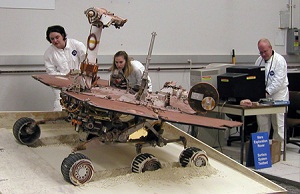NASA and Cleantech Open challenge inventors to store solar power
 Solar electric generation would undoubtedly be more pervasive if energy storage were as advanced as renewable generation technology, but as long as the sun doesn’t shine in the dark and batteries die, there will be a roadblock for solar.
Solar electric generation would undoubtedly be more pervasive if energy storage were as advanced as renewable generation technology, but as long as the sun doesn’t shine in the dark and batteries die, there will be a roadblock for solar.
NASA hopes to help speed along a solution.
NASA is teaming up with The Cleantech Open, the world’s largest clean technology business competition, to challenge entrepreneurs and inventors to get busy finding genius ways to store power.
While NASA officials know such technology would be extremely valuable here on Earth, it’s offering a hefty $1.5 million incentive to inventors and entrepreneurs to create something that will power robotics during prolonged sunless periods in space.
The Night Rover Challenge is to demonstrate solar energy collection and storage systems suitable for rovers to operate through several cycles of daylight and darkness, according to a release about the contest. During daylight, systems can collect photons or thermal energy from the sun. During darkness, the stored energy would be used to move the rover toward a destination and to continue its exploration work.
“NASA has not yet operated vehicles under the conditions being addressed in this Challenge,” said David Steitz, a NASA spokesman. “For short duration periods of darkness, spacecraft typically use energy stored in batteries and then recharge them during periods of sunlight.”
The Night Rover Challenge is one of NASA’s Centennial Challenges. There have been 21 such competitions since 2005 and NASA has awarded winners more than $4.5 million.
NASA's Centennial Challenges seek unconventional solutions to problems of interest to the agency and the nation, according to a release about the competition. NASA provides the prize purse, but the competitions are managed by non-profit organizations that cover the cost of operations through commercial or private sponsorships.
While previous winners have gone on to form successful businesses with continuing financial interest and support from NASA, this may be the first challenge with major terrestrial implications.
Steitz gave examples of previously successful Centennial Challenge winners like Peter Homer who won the Astronaut Glove Challenge to prevent hand fatigue and has gone on to sign long-term contracts with NASA for space suits.
“Masten Space Systems and Armadillo Aerospace won prizes in the Lunar Lander Challenge in 2009,” Steitz said. “Both are pursuing opportunities in the sub-orbital launch business.”
This is the first time NASA has partnered with The Cleantech Open for one of its Centennial Challenges.
"The Cleantech Open runs the world's largest clean technology business competition and is a proven leader in developing clean technology startup entrepreneurs," program executive for NASA's Centennial Challenges Program Larry Cooper said in a statement. "The team has significant experience in tech entrepreneurship and innovation, and access to expertise in aerospace, making them a great choice to manage the Night Rover challenge. We look forward to the competition and bringing together innovative teams with creative problem-solving ideas."
Image courtesy of NASA.



